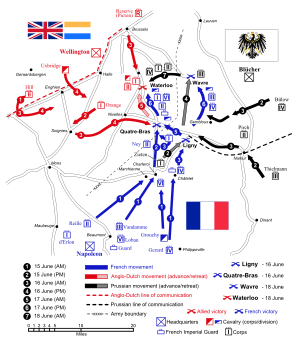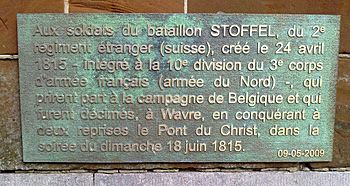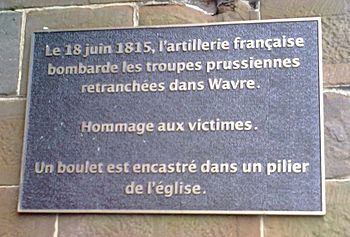Battle of Wavre facts for kids
Quick facts for kids Battle of Wavre |
|||||||
|---|---|---|---|---|---|---|---|
| Part of the War of the Seventh Coalition | |||||||
|
|||||||
| Belligerents | |||||||
| Commanders and leaders | |||||||
| Strength | |||||||
| 32,000-33,000 80 guns |
17,000-24,000 48 guns |
||||||
| Casualties and losses | |||||||
| 2,500 killed, wounded or captured | 2,500 killed, wounded or captured | ||||||
The Battle of Wavre was a key battle fought on June 18–19, 1815. It was the last major military action of the Hundred Days campaign. This was the final part of the Napoleonic Wars.
The battle took place between the French army, led by Marshal Emmanuel de Grouchy, and a part of the Prussian army. The Prussian forces were led by General Johann von Thielmann. This fight was important because it kept many French soldiers busy. These soldiers could not join Napoleon at the Battle of Waterloo. This helped Napoleon's enemies win at Waterloo.
Contents
Why the Battle of Wavre Happened
After losing the Battle of Ligny two days earlier, the Prussian army retreated. They moved north and gathered at Wavre. Meanwhile, Wellington's army won a small victory at Quatre Bras. But they could not help the Prussians at Ligny. So, Wellington's army also moved north to a strong position at Waterloo.
Napoleon then sent most of his army after Wellington. He ordered Marshal Grouchy to chase the retreating Prussians. Grouchy's force had about 33,000 men and 80 cannons.
French Army Units
Grouchy's army was made up of several groups:
- III Corps (General Dominique Vandamme) with 17,099 infantry and 38 cannons.
- IV Corps (General Étienne Maurice Gérard) with 15,013 infantry and 38 cannons.
- II Cavalry Corps (General Remy Exelmans) with 3,392 cavalry and 12 cannons.
- IV (Hussars) Cavalry Division (General Pierre Soult) with 1,485 cavalry and 8 cannons.
Grouchy was slow in chasing the Prussians. This gave the Prussian leader, Prince Blücher, time. Blücher moved his main army to Wavre. From there, he secretly marched three of his four army groups to join Wellington at Waterloo.
The remaining Prussian group was the III Corps. This group, led by Thielmann, had about 17,000 men and 48 cannons. Their job was to follow the main Prussian army. But if the French showed up in large numbers, Thielmann was to stop them. This would prevent the French from reaching Blücher's main army.
Getting Ready for Battle
French Plans and Movements
On June 18, 1815, around 6:00 AM, Grouchy told Napoleon that the Prussians had left Tourinnes. He said he was rushing to Wavre. By 10:00 AM, Grouchy reported that Prussian groups were marching towards Brussels. He thought they planned to join Wellington. Grouchy believed he could stop the Prussians at Wavre. This would keep them from helping Wellington.
Around 11:30 AM, Grouchy and his commanders heard the sound of cannons. This was the start of the Battle of Waterloo. Grouchy's commanders, especially General Gérard, wanted to "march to the sound of the guns." This meant going to help Napoleon.
But Grouchy had clear orders from Napoleon to go to Wavre and fight the Prussians there. He knew Napoleon had punished another general, Marshal Ney, for not following orders earlier. So, Grouchy decided to stick to his orders. He thought Napoleon had enough soldiers to beat Wellington.
Soon after, French cavalry found strong Prussian positions near Wavre. At 4:00 PM, another order arrived from Napoleon. It repeated the instruction for Grouchy to attack the Prussians.
Prussian Plans and Movements
Blücher had told Thielmann to defend Wavre if Grouchy's forces arrived in strength. Otherwise, Thielmann was to follow the main Prussian army towards Waterloo. Thielmann was about to leave Wavre when French soldiers arrived around 4:00 PM. The French artillery immediately started firing.
Thielmann realized the French were serious about crossing the river. He decided to stop his whole army and defend Wavre.
The town of Wavre is on the north side of the Dyle River. It had two stone bridges connecting it to a suburb on the other side. There were also wooden bridges nearby. The Dyle River was swollen from heavy rain.
Prussian Defenses at Wavre
Thielmann set up his troops carefully:
- The 12th Brigade was placed behind Bierges. They barricaded the bridge there.
- The 10th Brigade stood behind Wavre.
- The 11th Brigade was positioned across the Brussels road.
- Cavalry was kept in reserve.
- Cannons were placed along the high ground.
The part of Wavre on the south side of the river was held by light troops. The main bridge was barricaded. Houses near the river were quickly prepared for defense.
By mistake, a large part of Thielmann's force, the 9th Brigade, marched away. This left Thielmann with only about 15,200 men. He now had to fight Grouchy's much larger force of 33,765 men. Despite this, Thielmann's position was strong and well-defended.
The Battle Begins
In the late afternoon of June 18, 1815, Grouchy's army attacked the Prussians. This happened while Napoleon was fighting Wellington at Waterloo. The French aimed to cross the Dyle River at Wavre and Limal.
General Vandamme started the attack at 4:00 PM. He used cannons and then sent soldiers to take the bridges. Marshal Grouchy ordered cavalry and infantry to attack the bridge at Bas-Wavre. Another division attacked the bridge at Bierges.
Prussian soldiers defended the Bierges bridge by removing its wooden parts. They also charged the French to stop them from fixing it. At Wavre, the Prussians held the stone bridge for a while. When the French finally crossed, a fierce street fight began. The Prussians pushed the French back across the bridge several times. This back-and-forth fighting continued all night.
The French also tried to attack Bas-Wavre, but the Prussians had destroyed that bridge. Attacks on the Bierges bridge also failed. The ground was muddy, and the Prussian defense was strong.
Around 8:00 PM, the French attack at Waterloo completely failed. Napoleon's army was defeated. Meanwhile, Grouchy's troops had crossed the Dyle River. But the remains of Napoleon's army were fleeing south.
Fighting started again early the next morning. By 9:00 AM, the French had taken the forest south of Limal. Thielmann then decided to retreat. He heard the news of Napoleon's defeat at Waterloo at 10:00 AM, just as his retreat began.
Grouchy was planning to march on Brussels when he heard the news of Napoleon's defeat at 10:30 AM. He was shocked. Grouchy realized his army was in danger of being trapped. He quickly ordered his cavalry to secure the bridges. Then, he began a fast retreat back to Paris. The French had held the battlefield for only 30 minutes.
What Happened in the End
The Battle of Wavre was a tactical victory for the French. They pushed the Prussians back. However, this victory didn't help Napoleon. He had already lost the Battle of Waterloo.
The Prussians at Wavre had done their job. They held their ground long enough for Blücher to send 50,000 Prussian troops to help Wellington at Waterloo. Also, Thielmann's 17,000 Prussian soldiers kept 33,000 French troops busy. These French soldiers could have changed the outcome at Waterloo.
So, for the Prussians, the Battle of Wavre was a huge success. It played a big part in the final victory at Waterloo.
More to Explore
- Order of Battle of the Waterloo Campaign
- List of Napoleonic battles






